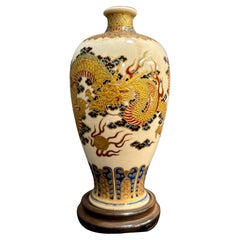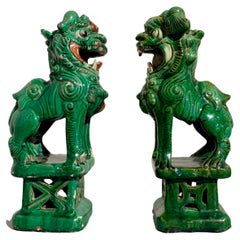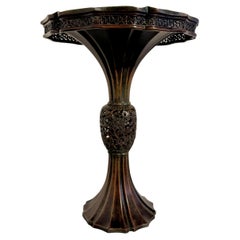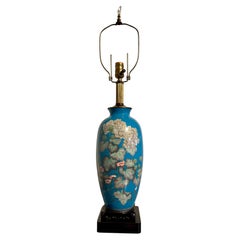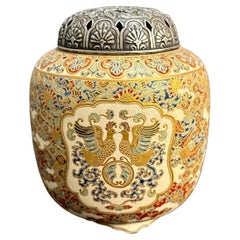Questions & Answers
Our trusted network of 1stDibs sellers answer common questions
What is a Chinese screen?
1 Answer

A Chinese screen can refer to a number or things, including standing folding room dividers, architectural window or door screen panels, or even decorative latticework hangings.

Lotus GallerySeptember 23, 2020
Related Questions
- What are Japanese screens called?1 Answer
- What is a dressing screen called?1 Answer
- What is a fireplace screen called?1 Answer
- What is the screen in front of a fireplace called?1 Answer
- What is a Japanese low screen used for?1 Answer
Shop for Chinese Four Panel Screen on 1stDibs
Vintage Khmer Cast Bronze Head of Shiva, Angkor Wat Style, 1970's, Thailand
Located in Austin, TX
A well cast vintage Khmer, Angkor Wat style, bronze head of Shiva, circa 1970's, Thailand.
Shiva, the Hindu god of creation, change and destruction, is identified by the third eye...
Category
Vintage 1970s Thai Sculptures and Carvings
Materials
Bronze
Japanese Satsuma Dragon Vase, Meiji Period, c 1900, Japan
By Satsuma
Located in Austin, TX
A fantastic small Japanese Satsuma vase with image of writhing dragons, Meiji Period, circa 1900, Japan.
The vase of elegant baluster form, with a slightly flared foot, slender body...
Category
Antique Early 1900s Japanese Meiji Ceramics
Materials
Ceramic, Porcelain, Pottery, Stoneware, Hardwood
Chinese Green Glazed Foo Lions, Near Pair, Late 19th Century, China
Located in Austin, TX
A charming near pair of Chinese green glazed foo lion joss stick holders, late 19th century, China.
The delightful foo lions, also referred to as foo dogs, crafted as joss (incens...
Category
Antique Late 19th Century Chinese Qing Sculptures and Carvings
Materials
Stoneware
Small Japanese Lacquer Duck Incense Box, Kogo, Meiji Period, Late 19th Century
Located in Austin, TX
An exquisite Japanese Meiji Period small lacquer incense box, kogo, in the form of a duck or goose, late 19th century, Japan.
The delicate lacquer box, known as a kogo in Japanese, ...
Category
Antique Late 19th Century Japanese Meiji Lacquer
Materials
Lacquer
Japanese Silver Wire Cloisonne Vase Lamp, Meiji Period, c 1900, Japan
Located in Austin, TX
A vibrant Japanese turquoise ground and silver wire cloisonne vase, now mounted as a lamp, Meiji Period, circa 1900, Japan.
The tall vase of elegant rouleau shape, with a straight neck and body, slightly tapered food, and everted mouth. Crafted in the cloisonne technique upon a copper ground, the silver wires stand out and shimmer against the bright turquoise enamel ground. An ebullient design of blossoming peony (botanical) and morning glory (asago) graces the body of the vase. The large and heavy blooms of white peony especially striking and contrasting nicely with the more delicate and almost shy pastel morning glory blossoms hiding behind the large leaves.
The cloisonne enamels especially well done within the silver cloisons, with the leaves and flowers displaying masterful shading. The foot decorated with a geometric and floral border.
The vase drilled and wired and now mounted as a lamp. Set upon two wood bases. The actual lamp of brass plate, set with a single socket and tall, adjustable harp.
The lamp is topped by an antique 19th century Chinese Qing Dynasty tumble polished natural rock crystal. The crystal finial originally served as a Chinese Mandarin hat finial...
Category
Antique Early 1900s Japanese Meiji Table Lamps
Materials
Rock Crystal, Silver, Brass, Copper
Chinese Export Silver Dragon Spoon by Wang Hing & Co., Late 19th Century
By Wang Hing & Co.
Located in Austin, TX
A very fine and charming Chinese export silver spoon in the form of a dragon, by Wang Hing & Co., Qing Dynasty, late 19th century, China.
The small spoon masterfully designed with...
Category
Antique 1890s Chinese Chinese Export Metalwork
Materials
Silver
Shop More furniture from Lotus Gallery on 1stDibs
Japanese Bronze Flower Vase, Edo to Meiji Period, circa 1860, Japan
Located in Austin, TX
A striking Japanese cast and carved patinated bronze trumpet mouth vase for flower displays, Edo to Meiji Period, mid 19th century, circa 1860, Japan.
The tall and elegant bronze fl...
Category
Antique Mid-19th Century Japanese Edo Metalwork
Materials
Bronze
Japanese Silver Wire Cloisonne Vase Lamp, Meiji Period, c 1900, Japan
Located in Austin, TX
A vibrant Japanese turquoise ground and silver wire cloisonne vase, now mounted as a lamp, Meiji Period, circa 1900, Japan.
The tall vase of elegant rouleau shape, with a straight neck and body, slightly tapered food, and everted mouth. Crafted in the cloisonne technique upon a copper ground, the silver wires stand out and shimmer against the bright turquoise enamel ground. An ebullient design of blossoming peony (botanical) and morning glory (asago) graces the body of the vase. The large and heavy blooms of white peony especially striking and contrasting nicely with the more delicate and almost shy pastel morning glory blossoms hiding behind the large leaves.
The cloisonne enamels especially well done within the silver cloisons, with the leaves and flowers displaying masterful shading. The foot decorated with a geometric and floral border.
The vase drilled and wired and now mounted as a lamp. Set upon two wood bases. The actual lamp of brass plate, set with a single socket and tall, adjustable harp.
The lamp is topped by an antique 19th century Chinese Qing Dynasty tumble polished natural rock crystal. The crystal finial originally served as a Chinese Mandarin hat finial...
Category
Antique Early 1900s Japanese Meiji Table Lamps
Materials
Rock Crystal, Silver, Brass, Copper
Japanese Satsuma Incense Burner, Koro, with Silver Lid, Meiji Period, Japan
Located in Austin, TX
A fantastic Japanese Satsuma incense burner, koro, with phoenix and brocade designs and a silver lid, Meiji Period, late 19th century, Japan.
The cens...
Category
Antique 1890s Japanese Meiji Ceramics
Materials
Silver
Japanese Satsuma Dragon Vase, Meiji Period, c 1900, Japan
By Satsuma
Located in Austin, TX
A fantastic small Japanese Satsuma vase with image of writhing dragons, Meiji Period, circa 1900, Japan.
The vase of elegant baluster form, with a slightly flared foot, slender body...
Category
Antique Early 1900s Japanese Meiji Ceramics
Materials
Ceramic, Porcelain, Pottery, Stoneware, Hardwood
Worcester Porcelain "Dragons in Compartments" Heart Shaped Dish, early 19th c
By Chamberlains Worcester
Located in Austin, TX
A fun and colorful English Chamberlains Worcester "Dragons in Compartments" heart or ruyi shaped enameled soft paste porcelain dish, early 19th century, circa 1810, Worcester, Englan...
Category
Antique Early 19th Century English George III Porcelain
Materials
Porcelain
Kunisada II Woodblock Triptych "Twilight Snow at Mount Hira", Edo Period, c 1850
Located in Austin, TX
A fantastic framed Japanese woodblock triptych by Utagawa Kunisada II (Toyokuni IV) entitled "Twilight Snow at Mount HIra" from the series "Eight Views of Omi", Edo period, circa 185...
Category
Antique Mid-19th Century Japanese Edo Prints
Materials
Metal
Chinese Export Porcelain "Pronk Arbor" Dish, Qianlong Period, c 1738, China
By Cornelis Pronk
Located in Austin, TX
A fine and rare Chinese Export famille rose enameled porcelain "Pronk Arbor" plate, 18th century, Qianlong Period, circa 1738, China.
A beautifully decorated Chinese Export porcelai...
Category
Antique 1730s Chinese Chinese Export Ceramics
Materials
Enamel

